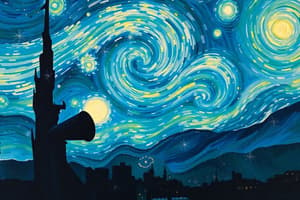Podcast
Questions and Answers
Why do space telescopes, like the Hubble Space Telescope, provide clearer images compared to optical telescopes on Earth?
Why do space telescopes, like the Hubble Space Telescope, provide clearer images compared to optical telescopes on Earth?
- Space telescopes are closer to the objects they observe.
- Space telescopes use stronger lenses than Earth-based telescopes.
- Space telescopes avoid atmospheric interference. (correct)
- Space telescopes can detect a wider range of electromagnetic radiation.
All artificial satellites orbit stars.
All artificial satellites orbit stars.
False (B)
What force is primarily responsible for the formation of a protostar from a nebula?
What force is primarily responsible for the formation of a protostar from a nebula?
Gravity
A _______ is a mixture of frozen gases, ice, dust, and rock that moves in an elliptical orbit around the Sun.
A _______ is a mixture of frozen gases, ice, dust, and rock that moves in an elliptical orbit around the Sun.
Match the following planets with their classification:
Match the following planets with their classification:
A star that is much more massive than our sun is most likely to end its life as a:
A star that is much more massive than our sun is most likely to end its life as a:
Constellations are defined as planets which appear to form patterns and are used for navigation.
Constellations are defined as planets which appear to form patterns and are used for navigation.
What evidence supports the Big Bang Theory?
What evidence supports the Big Bang Theory?
Why does Earth maintain a consistent orbit around the Sun?
Why does Earth maintain a consistent orbit around the Sun?
The Earth's axial tilt is the primary cause of varying day lengths throughout the year, while the revolution around the sun is less important.
The Earth's axial tilt is the primary cause of varying day lengths throughout the year, while the revolution around the sun is less important.
Describe how Earth's rotation affects our daily lives.
Describe how Earth's rotation affects our daily lives.
A solar eclipse can only occur during a ______ moon, when it passes directly between Earth and the Sun.
A solar eclipse can only occur during a ______ moon, when it passes directly between Earth and the Sun.
Match the following terms with their corresponding definitions:
Match the following terms with their corresponding definitions:
Why does the Moon have extreme temperature variations compared to Earth?
Why does the Moon have extreme temperature variations compared to Earth?
Spring tides are weaker than neap tides due to the alignment of the Sun, Earth, and Moon during the first and last quarter moon phases.
Spring tides are weaker than neap tides due to the alignment of the Sun, Earth, and Moon during the first and last quarter moon phases.
Explain how the tilt of Earth's axis and its orbit around the Sun cause seasons.
Explain how the tilt of Earth's axis and its orbit around the Sun cause seasons.
Flashcards
Gravity
Gravity
The force of attraction between any two objects; depends on mass and distance.
Orbit
Orbit
The curved path one object takes around another object in space.
Inertia
Inertia
The tendency of an object in motion to stay in motion in a straight line.
Revolution
Revolution
Signup and view all the flashcards
Seasons
Seasons
Signup and view all the flashcards
Rotation
Rotation
Signup and view all the flashcards
Solar Eclipse
Solar Eclipse
Signup and view all the flashcards
Lunar Eclipse
Lunar Eclipse
Signup and view all the flashcards
Telescope
Telescope
Signup and view all the flashcards
Planet
Planet
Signup and view all the flashcards
Moon/Satellite
Moon/Satellite
Signup and view all the flashcards
Comet
Comet
Signup and view all the flashcards
Nebula
Nebula
Signup and view all the flashcards
Black Hole
Black Hole
Signup and view all the flashcards
Constellation
Constellation
Signup and view all the flashcards
Light-Year
Light-Year
Signup and view all the flashcards





